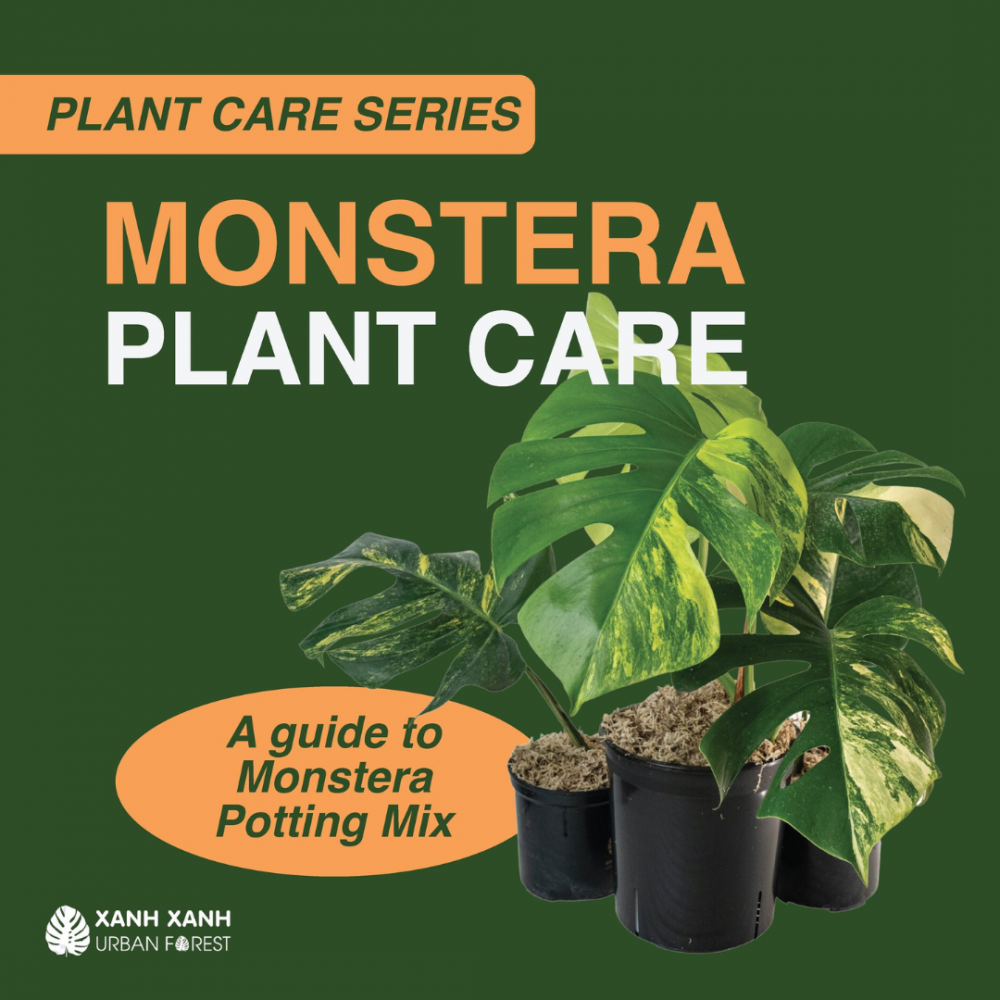Table of Contents
1. Introduction
Monstera is a well-liked and attractive plant with broad, lush leaves. To help your Monstera thrive, it’s important to choose the right potting mix. Xanh Xanh Urban Forest has detailed instructions on how to make the perfect potting mix for Monstera. With their help, your Monstera will grow healthy and lush, adding a touch of elegance and freshness to any living space.

2. The potting mix for Monstera should meet the following criteria
Porous and well-drained
Monstera has a strong root system that needs plenty of air to breathe. The soil will drain better with a permeable potting mix, which will also help the roots grow properly and stop root rot. So that the roots may receive the necessary oxygen without becoming waterlogged, the potting mix should have a healthy balance of air and water.

Rich in nutrients
Evergreen Monstera plants must have a lot of fertilizers to grow and thrive. The potting mix ought to supply the plant with all the vital nutrients, including nitrogen, phosphorus, and potassium. It is preferable to periodically release the nutrients over time so that the Monstera plant can use them as needed.
Free of disease and pests
The potting mix should be free of disease and pests that can harm the plant. This is important to prevent the plant from becoming sick or infested.
3. Choosing the right potting mix for Monstera
There are a variety of potting mixes that can be used for Monstera. Some common options include:

- Peat moss is a type of organic matter that is made up of partially decomposed sphagnum moss. It is an incredible choice for growing mediums because it is portable, porous, and properly retains moisture. Peat moss is a limited resource, so it must be used carefully.
- Sphagnum moss, a type of moss, can be found in bogs and wetland regions. It has qualities similar to peat moss, but because it is a permanent resource, it is more environmentally friendly.
- A number of years’ worth of pine tree bark is used to create aged bark, also known as pine bark. Because it is porous and aids in aerating the soil in order to retain moisture, it is an outstanding option for growing mediums.
- The exterior husk of coconuts is used to generate a natural fiber known as coconut coir. It is an ideal choice for a medium for growth because it is portable, porous, and aids in moisture retention. In addition, it is a sustainable replacement for peat moss.
- Lightweight and porous volcanic rock is known as pumice. It is an awesome choice for growing mediums because it increases drainage and aerates the soil and improves drainage.
- Perlite is a type of volcanic glass that has been expanded. It is lightweight and porous, and it helps to improve drainage and aeration in growing mediums.
- Vermiculite is a type of mica that has been expanded. It is lightweight, porous, and holds moisture well. Additionally, it helps the growth environment have better drainage and aeration.
Besides the choices indicated above, you might mix together other potting mixes to make your own combination that is customized for your Monstera plant’s particular demands.
4. Bottom drainage
It’s crucial to fill the pot’s bottom with an additional layer of drainage material. This will lessen the opportunity for water collection, leading to root rot. Some common drainage materials include:
- Pebbles: Pebbles are small, smooth stones that are often used in aquariums. They are a good choice for drainage because they are lightweight and porous. Pebbles are also relatively inexpensive and easy to find.
- Gravel: Gravel is larger than pebbles and has sharper edges. It is also a good choice for drainage, but it can be heavier than pebbles. For plants that require good drainage, gravel is a good solution.
- Pottery shards: Broken bits of pottery are known as pottery shards and are frequently utilized in gardening. They are a fantastic option for drainage because they aerate the soil and are permeable. Pottery shards are also rather cheap and easy to find.
- Perlite: Perlite is a lightweight, volcanic rock that has been expanded. Recognizing that it is porous and helps boost aeration and drainage in the potting mix, it is a great choice for drainage. For plants that need necessary aeration and drainage, perlite is a suitable solution.
- Vermiculite: Lightweight vermiculite is a mica-based mineral that encountered expansion. It is a fantastic alternative for drainage because it is porous and helps with moisture retention. Vermiculite is a great choice for plants that require increased moisture retention.
5. Suggestions for integrating draining into a pot

Add a layer of drainage material that is at least 2 inches thick to the pot’s bottom. It will be possible for water to flow away from the roots as a result.
To prevent the soil from clogging the drainage pores in the pot, the drainage material should be larger than the openings. By doing this, you will be sure that the pot’s water drainage system is accessible.
The drainage material should be spotless and debris-free. As a result, you’ll be able to stop mold and bacteria from growing.
At the bottom of the pot, the drainage material should be dispersed appropriately.
This will help to ensure that water is able to drain evenly throughout the pot.
By following these tips, you can help ensure that your Monstera plant has the right potting mix to thrive and produce new leaves.
If you have any questions, you can contact us via:

